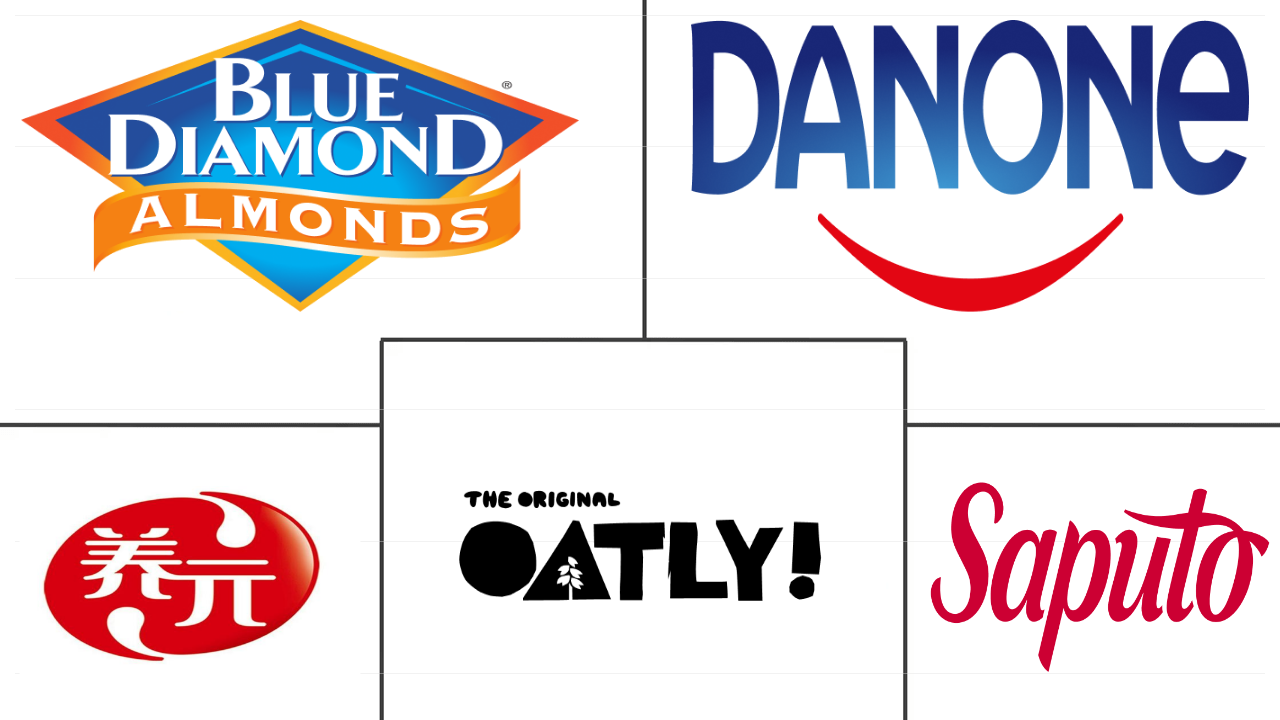Market Size of dairy alternatives Industry
|
|
Study Period | 2017 - 2029 |
|
|
Market Size (2024) | USD 32.29 Billion |
|
|
Market Size (2029) | USD 53.6 Billion |
|
|
Largest Share by Distribution Channel | Off-Trade |
|
|
CAGR (2024 - 2029) | 10.66 % |
|
|
Largest Share by Region | North America |
Major Players |
||

|
||
|
*Disclaimer: Major Players sorted in no particular order |
Dairy Alternatives Market Analysis
The Dairy Alternatives Market size is estimated at 32.29 billion USD in 2024, and is expected to reach 53.6 billion USD by 2029, growing at a CAGR of 10.66% during the forecast period (2024-2029).
32.29 Billion
Market Size in 2024 (USD)
53.6 Billion
Market Size in 2029 (USD)
8.54 %
CAGR (2017-2023)
10.66 %
CAGR (2024-2029)
Largest Market by Category
65.47 %
value share, Non-Dairy Milk, 2023

Growing investments in plant-based milk marketspace, an increasing vegan and vegetarian population, and nutritional benefits of plant-based milk, is drivng segmental growth.
Largest Market by Distribution Channel
93.96 %
value share, Off-Trade, 2023
The ease of product comparibility enabling them to read the labels which is provoking them to make smarter choices in the market is largely driving the segmental growth.
Fastest-growing Market by Category
21.40 %
Projected CAGR, Non-Dairy Cheese, 2024-2029
Steady increase in consumer awareness levels about ethics of producing dairy foods, and the impact of animal husbandry on the environment are the key factors driving the segment.
Fastest-growing Market by Distribution Channel
10.92 %
Projected CAGR, Off-Trade, 2024-2029
The technological advancements making freedom to browse digital catalogs without any hurry in a priceless way is driving off-trade retail channels through online stores.
Leading Market Player
10.99 %
market share, Danone SA, 2022

The presence of exhaustive product offerings along with larger distribution network and a wider presence throughout the regions has made Danone S.A a leading market player.
The sales through off trade channels particularly through supermarket/ hypermarket and online drove the segment
- By distribution channel, the global dairy alternatives market has been divided into two major segments: on-trade retailing and off-trade retailing. The off-trade channel plays a major role in the sales of dairy alternative products worldwide. Among off-trade channels, supermarkets and hypermarkets are the most popular.
- Supermarkets and hypermarkets are considered ideal options for customers to shop, allowing them to select products from dairy alternatives like milk, yogurt, and ice cream. Thus, this channel is considered the primary sales channel for dairy alternative products. They account for more than 60% of overall sales worldwide.
- The online channel is projected to be the fastest-growing distribution channel for dairy alternatives, and it is anticipated to grow by 5.59% during 2023-2024. The number of e-commerce, grocery, or food delivery platforms is increasing in the market. As part of strategic expansion, leading retailers team up with purely online retailers to launch their own online services. For example, Morrisons, Booths, and Co-op's own-label products are also sold online via Amazon Fresh. Asda, Tesco, Amazon Fresh, Sainsbury's, Waitrose, Iceland, Morrisons, Gorillas, and Weezy offer same-day online delivery.
- With the growing vegan population and lactose intolerant consumers, the demand from the on-trade segment, especially fast food restaurants and cafes, is expected to increase the demand for different dairy alternative products.
Explosive plant-based milk consumption led by Asia Pacific consumers is fueling the market growth
- Global consumption of dairy alternatives grew by 41.7% from 2019 to 2023. Dairy alternatives have become a part of daily diets across countries globally. North America and Asia-Pacific are expected to be the largest regions in terms of dairy alternatives consumption, with market volume shares of 35% and 34.1%, respectively, in 2023.
- The rise in the vegan population, in line with the rising awareness of plant-based nutrition, is driving the demand for dairy alternatives in the Asia-Pacific region. China, Japan, and South Korea exhibit significantly higher consumption of dairy alternatives compared to other Asian countries. In 2023, the three countries are expected to collectively hold a 79.77% share of the total consumption of dairy alternative products in the region.
- In 2021, around 67.8 thousand metric tons of soybeans were used to produce soy milk and soy milk-based products in Japan, resulting in the production of approximately 123 thousand kiloliters of soy milk. In Japan, beverages with the term "soy milk" refer to unprocessed soy milk that does not contain additional sugar, salt, or vegetable oils. The per capita consumption of dairy alternatives is estimated to reach 0.45 kg annually in 2029, up by 15.47% from 0.39 kg in 2023 in Japan.
- In North America, dairy alternatives sales by value are estimated to expand by 28% during 2024-2027, reaching USD 13715 million in 2027. Plant-based milk is significantly consumed across the region, with soy and almond milk being the most popular in key countries such as the United States, Canada, and Mexico. The United States has the highest production volume of almonds of any country worldwide, amounting to around 2,002,742 tons annually. Such factors are increasing the production of almond milk every year.
Dairy Alternatives Industry Segmentation
Non-Dairy Butter, Non-Dairy Cheese, Non-Dairy Ice Cream, Non-Dairy Milk, Non-Dairy Yogurt are covered as segments by Category. Off-Trade, On-Trade are covered as segments by Distribution Channel. Africa, Asia-Pacific, Europe, Middle East, North America, South America are covered as segments by Region.
- By distribution channel, the global dairy alternatives market has been divided into two major segments: on-trade retailing and off-trade retailing. The off-trade channel plays a major role in the sales of dairy alternative products worldwide. Among off-trade channels, supermarkets and hypermarkets are the most popular.
- Supermarkets and hypermarkets are considered ideal options for customers to shop, allowing them to select products from dairy alternatives like milk, yogurt, and ice cream. Thus, this channel is considered the primary sales channel for dairy alternative products. They account for more than 60% of overall sales worldwide.
- The online channel is projected to be the fastest-growing distribution channel for dairy alternatives, and it is anticipated to grow by 5.59% during 2023-2024. The number of e-commerce, grocery, or food delivery platforms is increasing in the market. As part of strategic expansion, leading retailers team up with purely online retailers to launch their own online services. For example, Morrisons, Booths, and Co-op's own-label products are also sold online via Amazon Fresh. Asda, Tesco, Amazon Fresh, Sainsbury's, Waitrose, Iceland, Morrisons, Gorillas, and Weezy offer same-day online delivery.
- With the growing vegan population and lactose intolerant consumers, the demand from the on-trade segment, especially fast food restaurants and cafes, is expected to increase the demand for different dairy alternative products.
| Category | |||||||||||
| Non-Dairy Butter | |||||||||||
| Non-Dairy Cheese | |||||||||||
| Non-Dairy Ice Cream | |||||||||||
| |||||||||||
| Non-Dairy Yogurt |
| Distribution Channel | |||||||
| |||||||
| On-Trade |
| Region | ||||||||||||||||
| ||||||||||||||||
| ||||||||||||||||
| ||||||||||||||||
| ||||||||||||||||
| ||||||||||||||||
|
Dairy Alternatives Market Size Summary
The Dairy Alternatives Market is experiencing significant growth, driven by increasing consumer demand for plant-based products. This market is characterized by a diverse range of products, including plant-based milk, yogurt, and cheese, which are becoming integral to daily diets worldwide. The market is segmented into on-trade and off-trade distribution channels, with supermarkets and hypermarkets being the primary sales venues. However, the online channel is emerging as the fastest-growing distribution method, facilitated by the rise of e-commerce and food delivery platforms. The market's expansion is further supported by strategic partnerships between traditional retailers and online platforms, enhancing accessibility and convenience for consumers.
The demand for dairy alternatives is particularly strong in regions like North America and Asia-Pacific, where the vegan population and lactose-intolerant consumers are on the rise. In Asia-Pacific, countries such as China, Japan, and South Korea are leading in consumption, driven by increased awareness of plant-based nutrition. The United States also plays a significant role in the market, with a high production volume of almonds supporting the popularity of almond milk. The market is fragmented, with key players like Blue Diamond Growers, Danone SA, and Oatly Group AB leading the charge. Innovations in plant-based products, such as new flavors of oat-based yogurt and vegan cheese varieties, are expected to further propel market growth during the forecast period.
Dairy Alternatives Market Size - Table of Contents
-
1. MARKET SEGMENTATION (includes market size in Value in USD and Volume, Forecasts up to 2029 and analysis of growth prospects)
-
1.1 Category
-
1.1.1 Non-Dairy Butter
-
1.1.2 Non-Dairy Cheese
-
1.1.3 Non-Dairy Ice Cream
-
1.1.4 Non-Dairy Milk
-
1.1.4.1 By Product Type
-
1.1.4.1.1 Almond Milk
-
1.1.4.1.2 Cashew Milk
-
1.1.4.1.3 Coconut Milk
-
1.1.4.1.4 Hazelnut Milk
-
1.1.4.1.5 Hemp Milk
-
1.1.4.1.6 Oat Milk
-
1.1.4.1.7 Soy Milk
-
-
-
1.1.5 Non-Dairy Yogurt
-
-
1.2 Distribution Channel
-
1.2.1 Off-Trade
-
1.2.1.1 Convenience Stores
-
1.2.1.2 Online Retail
-
1.2.1.3 Specialist Retailers
-
1.2.1.4 Supermarkets and Hypermarkets
-
1.2.1.5 Others (Warehouse clubs, gas stations, etc.)
-
-
1.2.2 On-Trade
-
-
1.3 Region
-
1.3.1 Africa
-
1.3.1.1 By Category
-
1.3.1.2 By Distribution Channel
-
1.3.1.3 By Country
-
1.3.1.3.1 Egypt
-
1.3.1.3.2 Nigeria
-
1.3.1.3.3 South Africa
-
1.3.1.3.4 Rest of Africa
-
-
-
1.3.2 Asia-Pacific
-
1.3.2.1 By Category
-
1.3.2.2 By Distribution Channel
-
1.3.2.3 By Country
-
1.3.2.3.1 Australia
-
1.3.2.3.2 China
-
1.3.2.3.3 India
-
1.3.2.3.4 Indonesia
-
1.3.2.3.5 Japan
-
1.3.2.3.6 Malaysia
-
1.3.2.3.7 New Zealand
-
1.3.2.3.8 Pakistan
-
1.3.2.3.9 South Korea
-
1.3.2.3.10 Rest of Asia Pacific
-
-
-
1.3.3 Europe
-
1.3.3.1 By Category
-
1.3.3.2 By Distribution Channel
-
1.3.3.3 By Country
-
1.3.3.3.1 Belgium
-
1.3.3.3.2 France
-
1.3.3.3.3 Germany
-
1.3.3.3.4 Italy
-
1.3.3.3.5 Netherlands
-
1.3.3.3.6 Russia
-
1.3.3.3.7 Spain
-
1.3.3.3.8 Turkey
-
1.3.3.3.9 United Kingdom
-
1.3.3.3.10 Rest of Europe
-
-
-
1.3.4 Middle East
-
1.3.4.1 By Category
-
1.3.4.2 By Distribution Channel
-
1.3.4.3 By Country
-
1.3.4.3.1 Bahrain
-
1.3.4.3.2 Iran
-
1.3.4.3.3 Kuwait
-
1.3.4.3.4 Oman
-
1.3.4.3.5 Qatar
-
1.3.4.3.6 Saudi Arabia
-
1.3.4.3.7 United Arab Emirates
-
1.3.4.3.8 Rest of Middle East
-
-
-
1.3.5 North America
-
1.3.5.1 By Category
-
1.3.5.2 By Distribution Channel
-
1.3.5.3 By Country
-
1.3.5.3.1 Canada
-
1.3.5.3.2 Mexico
-
1.3.5.3.3 United States
-
1.3.5.3.4 Rest of North America
-
-
-
1.3.6 South America
-
1.3.6.1 By Category
-
1.3.6.2 By Distribution Channel
-
1.3.6.3 By Country
-
1.3.6.3.1 Argentina
-
1.3.6.3.2 Brazil
-
1.3.6.3.3 Rest of South America
-
-
-
-
Dairy Alternatives Market Size FAQs
How big is the Global Dairy Alternatives Market?
The Global Dairy Alternatives Market size is expected to reach USD 32.29 billion in 2024 and grow at a CAGR of 10.66% to reach USD 53.60 billion by 2029.
What is the current Global Dairy Alternatives Market size?
In 2024, the Global Dairy Alternatives Market size is expected to reach USD 32.29 billion.

